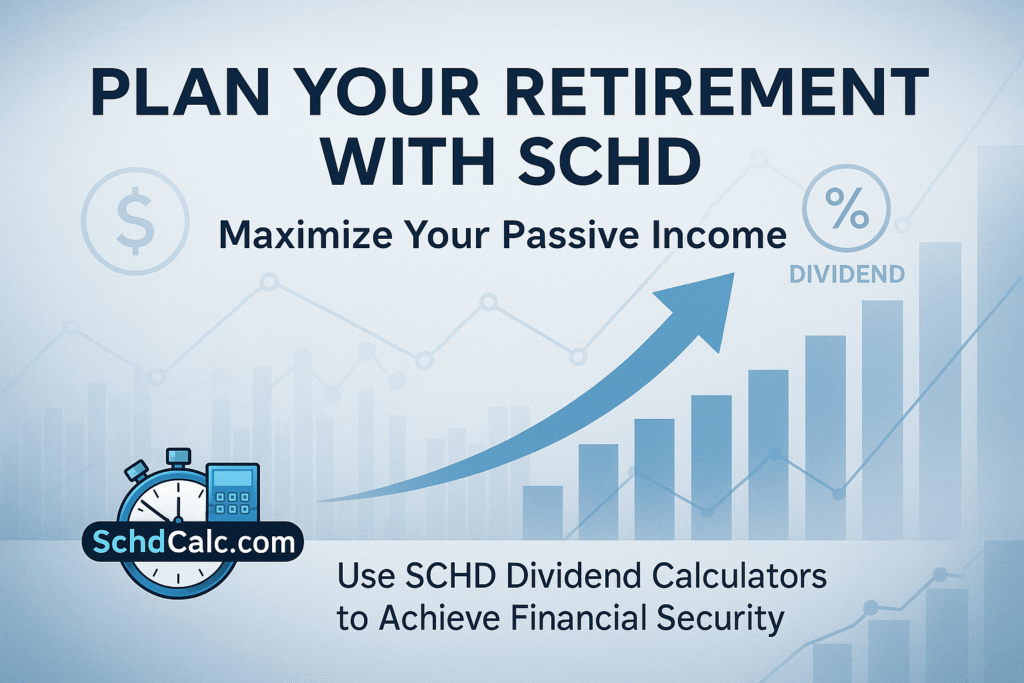If you are thinking about retirement and need a strategy to ensure steady income then the SCHD could be an optimal investment. Due to its reliable income and growth potential, it is now a favorite for many looking to build a secure retirement. So when it comes to plans for retiring, the SCHD can be more than an ETF. The fund is an investment tool that is designed to generate income through dividends and provide you with opportunities for long-term growth. The ETF is focused on companies that have a good dividend history. This is where dividend calculators for SCHD help you calculate your earnings and assess how your investment might grow over time. These calculators allow you to estimate the amount of dividends you could earn by analysing factors such as your investment value, dividend yield and the growth you expect. It is an easy way to see an idea of your expected income and assist you in planning for the kind of retirement that you are hoping for.
Understanding SCHD Dividend Calculators and its Key Features
SCHD dividend calculators will help you make dividend-based investment planning more accessible and precise. These calculators focus on the different factors such as dividend yield, payout frequency, and investment amount. Here I am a breakdown of their key features and the benefits they offer:
1. Accurate Dividend Projections:
When you enter your investment amount and dividend yield then our SCHD dividend calculators can estimate how much income you will receive over time. This helps you project your retirement income with a higher degree of confidence.
2. Payout Frequency Consideration:
As you know that the SCHD dividends are paid quarterly and the calculators account for this payment schedule which provides you a clear understanding of when and how you will receive payments.
3. Real-time Data:
These calculators typically provide you with real-time data from financial markets which implies that the calculations reflect the most up-to-date dividend yields and stock prices. This is especially valuable for long-term planning as it allows users to adapt their strategy to changing market conditions.
4. Customization:
You can customise the tool by adjusting variables such as initial investment, dividend yield or the number of shares you own. This flexibility allows for personalized retirement income forecasts.
How to Calculate Your Retirement Income Using SCHD Dividend Calculator – SCHDCALC.COM
To calculate your retirement income using the SCHD Dividend payout calculator, you must follow the given below steps that will help you properly calculate your income.
1. Input Your Investment Amount:
At first you enter the amount you plan to invest in SCHD. For instance if you invest $100,000 in SCHD, this becomes the base figure for your projections.
2. Enter the Current Dividend Yield
Dividend yield means the income return you get from your investment in SCHD. The calculator will ask for the current dividend yield which fluctuates but is typically available on the SCHD ETF’s official page. Therefore the SCHD typically offers a dividend yield around 3.5% to 4%.
3. Determine Payout Frequency:
The SCHD dividend ETF pays its dividends on a quarterly basis, so you will receive four dividend payments per year. This helps the calculator accurately predict how much income you will receive on a yearly basis.
4. Calculate Total Dividend Income:
After entering these values on the SCHD Calculator, our SCHD dividend calculator will show you your projected annual retirement income. This will be a result of multiplying the number of shares that you own by the projected dividend yield, considering any potential growth.
For example:
- Your Investment Amount: $100000
- Dividend Yield: 3.5%
- Annual Dividend Income: $100000 * 0.035 = $3500
That means you will receive $3500 annually in dividends, split across four quarterly payouts ($875 per quarter).
5. Reinvestment (Optional):
If you reinvest your dividends by purchasing additional SCHD shares then the total dividend income grows over time. Most of the dividend calculators allow you to use a reinvestment strategy that helps project compounded returns.
Why SCHD Dividend Yield is a Great Choice for Long-Term Retirement Strategies
When you are planning for retirement, it is essential to compare SCHD’s dividend yield with other stocks and ETFs to assess its suitability. SCHD has been consistently favoured for its ability to generate a reliable income stream while maintaining a solid track record of long-term growth. Now if I compare with many high-risk dividend stocks, SCHD focuses on quality companies with sustainable dividend policies which offer you the chance to earn a relatively high yield with lower risk.
1. High Yield and Stability:
As I told you earlier that the SCHD provides a current yield of around 3.6% which is competitive as compared to other dividend-paying stocks especially considering the lower risk. For example, the average dividend yield of the S&P 500 is around 2% which means that the SCHD’s yield is more attractive for retirement planning.
2. Long-Term Consistency:
SCHD is focused on high-quality and established companies that have a consistent record of paying dividends. This long-term stability is essential to retirement planning since you are looking for a steady income which is particularly important during volatile market conditions.
3. Low Volatility:
It is important to have stability long-term in retirement planning, as it is important to be confident of an ongoing income stream particularly in volatile market conditions.
How to Create a Passive Income Stream for Retirement with SCHD Dividend Calculators
Creating a passive income stream is one of the primary objectives for retirees. Now with the help of SCHD dividend calculators, it is possible to create an approach that will maximise passive income while minimising the risks. Here I am explaining how you can create a sustainable income stream:
- The earlier you start investing in SCHD, the more time your investment has to grow. Therefore if you invest like regular contributions such as monthly or quarterly deposits, it can increase the effect of compound interest.
- When you reinvest your dividends, you will have the opportunity to purchase more shares of SCHD in the long term. So when your investments grow which means your dividends also grow over time that results in a snowball effect that leads to more passive income.
- While SCHD is a great option for diversifying your portfolio across different dividend-paying stocks and bonds, it can provide additional protection.
- Always check the effectiveness of your SCHD investment using this calculator. If your income projections are changing because of fluctuations in yield or stock price then you may need to modify your strategy by making more investments or adjusting the amount you invest.
Dividend calculators for SCHD are powerful tools for anyone looking to create a steady income stream in retirement. When you input information such as the amount you invest, annual growth, the dividend rate and your reinvestment strategy, you will have a clear picture of how your dividends grow over time.
/* Tools Page Styles */
:root {
--primary-color: #1e3fa1;
--primary-hover: #15307d;
--secondary-color: #f8f9fa;
--text-primary: #333333;
--text-secondary: #666666;
--card-shadow: 0 3px 10px rgba(0, 0, 0, 0.08);
--card-border-radius: 8px;
--section-spacing: 60px;
}
/* Container and Layout */
.tools-page-container {
font-family: -apple-system, BlinkMacSystemFont, 'Segoe UI', Roboto, Oxygen-Sans, Ubuntu, Cantarell, 'Helvetica Neue', sans-serif;
color: var(--text-primary);
line-height: 1.6;
}
.tools-container {
max-width: 1200px;
margin: 0 auto;
padding: 0 20px;
}
/* Hero Section */
.tools-hero {
background-color: var(--primary-color);
color: white;
padding: 70px 0;
margin-bottom: 30px;
text-align: center;
}
.tools-hero h1 {
font-size: 2.5rem;
font-weight: 700;
margin-bottom: 20px;
color: white;
}
.hero-subtitle {
font-size: 1.2rem;
max-width: 800px;
margin: 0 auto;
line-height: 1.6;
}
/* Category Tabs */
.category-tabs {
background-color: white;
border-radius: var(--card-border-radius);
box-shadow: var(--card-shadow);
margin-bottom: 30px;
padding: 10px 0;
text-align: center;
}
.tab-button {
background: none;
border: 1px solid #ddd;
border-radius: 20px;
padding: 8px 15px;
margin: 5px;
font-size: 14px;
color: var(--text-secondary);
cursor: pointer;
transition: all 0.3s ease;
}
.tab-button.active, .tab-button:hover {
background-color: var(--primary-color);
border-color: var(--primary-color);
color: white;
}
/* Section Styles */
.tools-section {
padding: var(--section-spacing) 0;
}
.alt-bg {
background-color: var(--secondary-color);
}
.section-title {
font-size: 1.8rem;
font-weight: 700;
margin-bottom: 30px;
color: var(--text-primary);
position: relative;
padding-bottom: 10px;
}
.section-title::after {
content: "";
position: absolute;
bottom: 0;
left: 0;
width: 60px;
height: 4px;
background-color: var(--primary-color);
}
/* Tool Cards Grid */
.tools-grid {
display: grid;
grid-template-columns: repeat(auto-fill, minmax(320px, 1fr));
gap: 30px;
margin-bottom: 20px;
}
.tool-card {
background-color: white;
border-radius: var(--card-border-radius);
padding: 30px;
box-shadow: var(--card-shadow);
transition: transform 0.3s ease, box-shadow 0.3s ease;
display: flex;
flex-direction: column;
height: 100%;
}
.tool-card:hover {
transform: translateY(-5px);
box-shadow: 0 10px 20px rgba(0, 0, 0, 0.1);
}
.tool-icon {
width: 50px;
height: 50px;
margin-bottom: 20px;
display: flex;
align-items: center;
justify-content: center;
}
.tool-icon img, .tool-icon svg {
width: 100%;
height: 100%;
object-fit: contain;
}
.tool-icon svg {
color: var(--primary-color);
}
.tool-card h3 {
font-size: 1.25rem;
font-weight: 600;
margin-bottom: 15px;
color: var(--text-primary);
}
.tool-card p {
color: var(--text-secondary);
margin-bottom: 20px;
flex-grow: 1;
font-size: 0.95rem;
line-height: 1.5;
}
.tool-button {
display: inline-block;
background-color: var(--primary-color);
color: white;
text-decoration: none;
padding: 10px 20px;
border-radius: 4px;
font-weight: 500;
font-size: 0.9rem;
transition: background-color 0.3s ease;
text-align: center;
}
.tool-button:hover {
background-color: var(--primary-hover);
color: white;
}
/* Tools Category Box */
.tools-category-box {
display: flex;
background-color: white;
border-radius: var(--card-border-radius);
box-shadow: var(--card-shadow);
padding: 30px;
margin-bottom: 30px;
}
.category-icon {
flex-shrink: 0;
width: 50px;
height: 50px;
margin-right: 30px;
color: var(--primary-color);
}
.category-icon svg {
width: 100%;
height: 100%;
}
.category-content {
flex-grow: 1;
}
.tools-list-columns {
display: flex;
flex-wrap: wrap;
}
.tools-list-column {
flex: 1;
min-width: 250px;
padding-right: 20px;
}
.tools-list-column ul {
list-style: none;
padding: 0;
margin: 0;
}
.tools-list-column li {
position: relative;
padding: 8px 0 8px 25px;
border-bottom: 1px solid #f0f0f0;
}
.tools-list-column li::before {
content: "";
position: absolute;
left: 0;
top: 50%;
transform: translateY(-50%);
width: 16px;
height: 16px;
background-image: url("data:image/svg+xml,%3Csvg xmlns='http://www.w3.org/2000/svg' viewBox='0 0 24 24' fill='none' stroke='%231e3fa1' stroke-width='3' stroke-linecap='round' stroke-linejoin='round'%3E%3Cpath d='M5 12l5 5L20 7'%3E%3C/path%3E%3C/svg%3E");
background-size: contain;
background-repeat: no-repeat;
background-position: center;
}
.tools-list-column a {
color: var(--text-primary);
text-decoration: none;
transition: color 0.3s ease;
font-size: 0.95rem;
}
.tools-list-column a:hover {
color: var(--primary-color);
}
/* FAQ Section */
.faq-section {
background-color: var(--secondary-color);
padding: var(--section-spacing) 0;
}
.faq-section h2 {
font-size: 2rem;
font-weight: 700;
margin-bottom: 40px;
text-align: center;
}
.faq-container {
max-width: 800px;
margin: 0 auto;
}
.faq-item {
background-color: white;
border-radius: var(--card-border-radius);
margin-bottom: 20px;
overflow: hidden;
box-shadow: var(--card-shadow);
}
.faq-question {
padding: 20px;
background-color: white;
cursor: pointer;
position: relative;
display: flex;
align-items: center;
justify-content: space-between;
}
.faq-question h3 {
margin: 0;
font-size: 1.1rem;
font-weight: 600;
color: var(--text-primary);
}
.faq-toggle {
font-size: 24px;
color: var(--primary-color);
font-weight: bold;
}
.faq-answer {
padding: 0 20px;
max-height: 0;
overflow: hidden;
transition: max-height 0.3s ease, padding 0.3s ease;
}
.faq-item.active .faq-answer {
padding: 0 20px 20px;
max-height: 1000px;
}
.faq-answer p {
margin: 0;
color: var(--text-secondary);
line-height: 1.6;
}
/* Responsive Design */
@media (max-width: 768px) {
.tools-hero h1 {
font-size: 2rem;
}
.hero-subtitle {
font-size: 1rem;
}
.tools-grid {
grid-template-columns: 1fr;
}
.tools-category-box {
flex-direction: column;
padding: 20px;
}
.category-icon {
margin: 0 0 20px 0;
}
.tools-list-column {
flex: 0 0 100%;
padding-right: 0;
margin-bottom: 20px;
}
.faq-question h3 {
font-size: 1rem;
}
}
/* Dark Mode Support */
@media (prefers-color-scheme: dark) {
body.dark-mode-enabled .tools-page-container {
background-color: #1a1f2b;
color: #f0f0f0;
}
body.dark-mode-enabled .tool-card,
body.dark-mode-enabled .tools-category-box,
body.dark-mode-enabled .faq-item,
body.dark-mode-enabled .faq-question {
background-color: #242a38;
}
body.dark-mode-enabled .alt-bg {
background-color: #1a1f2b;
}
body.dark-mode-enabled .section-title,
body.dark-mode-enabled .faq-question h3,
body.dark-mode-enabled .tools-list-column a {
color: #f0f0f0;
}
body.dark-mode-enabled .tools-list-column li {
border-bottom-color: #3a4458;
}
body.dark-mode-enabled .tab-button {
color: #ddd;
border-color: #444;
}
body.dark-mode-enabled .tab-button:hover:not(.active) {
background-color: #333;
}
body.dark-mode-enabled .faq-section {
background-color: #1a1f2b;
}
body.dark-mode-enabled .category-tabs {
background-color: #242a38;
box-shadow: 0 2px 4px rgba(0, 0, 0, 0.3);
}
}
/* JavaScript for FAQ and Category Filter functionality */
document.addEventListener('DOMContentLoaded', function() {
// FAQ accordion functionality
const faqItems = document.querySelectorAll('.faq-item');
faqItems.forEach(item => {
const question = item.querySelector('.faq-question');
const toggle = item.querySelector('.faq-toggle');
question.addEventListener('click', function() {
// Toggle active class
const isActive = item.classList.contains('active');
// Close all other FAQs
faqItems.forEach(otherItem => {
otherItem.classList.remove('active');
otherItem.querySelector('.faq-toggle').textContent = '+';
});
// Toggle current FAQ
if (!isActive) {
item.classList.add('active');
toggle.textContent = '×';
} else {
toggle.textContent = '+';
}
});
});
// Category filter functionality
const tabButtons = document.querySelectorAll('.tab-button');
const toolCards = document.querySelectorAll('.tool-card');
tabButtons.forEach(button => {
button.addEventListener('click', function() {
// Remove active class from all buttons
tabButtons.forEach(btn => btn.classList.remove('active'));
// Add active class to clicked button
this.classList.add('active');
// Get selected category
const selectedFilter = this.getAttribute('data-filter');
// Filter tool cards
if (selectedFilter === 'all') {
toolCards.forEach(card => {
card.style.display = 'block';
});
} else {
toolCards.forEach(card => {
const categories = card.getAttribute('data-categories').split(' ');
if (categories.includes(selectedFilter)) {
card.style.display = 'block';
} else {
card.style.display = 'none';
}
});
}
});
});
});
{
"@context": "https://schema.org",
"@type": "Article",
"mainEntityOfPage": "https://www.schdcalc.com/how-to-use-schd-dividend-calculators-for-your-retirement-income/",
"headline": "How to Use SCHD Dividend Calculators for Your Retirement Income",
"description": "Learn how to effectively use SCHD dividend calculators to plan your retirement income and optimize your investment strategy with SCHD ETFs.",
"image": "https://www.schdcalc.com/wp-content/uploads/2025/05/How-to-Use-SCHD-Dividend-Calculators-to-Plan-Your-Retirement-Income.png",
"author": {
"@type": "Person",
"name": "Ronan Hayes",
"url": "https://www.schdcalc.com/author/ronanhayes/"
},
"publisher": {
"@type": "Organization",
"name": "SCHDcalc",
"logo": {
"@type": "ImageObject",
"url": "https://www.schdcalc.com/wp-content/uploads/2025/05/SCHD-Calculators.jpg"
}
},
"datePublished": "2025-06-01",
"dateModified": "2025-06-01",
"articleSection": "Finance",
"keywords": ["SCHD dividend calculator", "retirement income planning", "SCHD ETF calculator", "dividend income retirement", "SCHD retirement strategy"],
"mainEntity": {
"@type": "HowTo",
"name": "SCHD Dividend Calculator",
"url": "https://www.schdcalc.com/schd-dividend-calculator/",
"description": "A tool to calculate dividend income from SCHD ETF for retirement planning and financial strategies.",
"step": [
{
"@type": "HowToStep",
"name": "Input Your Investment Amount",
"url": "https://www.schdcalc.com/how-to-use-schd-dividend-calculators-for-your-retirement-income/#step1",
"text": "Start by entering the total amount you have invested in SCHD ETF to calculate potential dividends."
},
{
"@type": "HowToStep",
"name": "Set Dividend Reinvestment Option",
"url": "https://www.schdcalc.com/how-to-use-schd-dividend-calculators-for-your-retirement-income/#step2",
"text": "Choose whether to reinvest dividends or withdraw them for your retirement income."
},
{
"@type": "HowToStep",
"name": "View Results and Plan",
"url": "https://www.schdcalc.com/how-to-use-schd-dividend-calculators-for-your-retirement-income/#step3",
"text": "Review your estimated dividend income and adjust your strategy to meet retirement goals."
}
]
}
}



